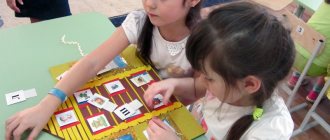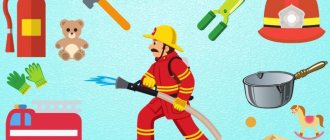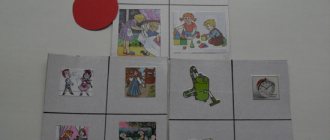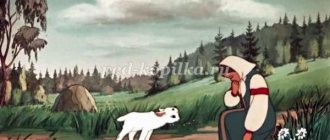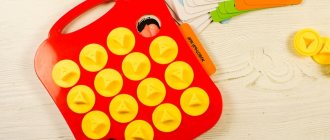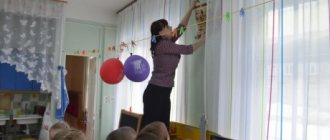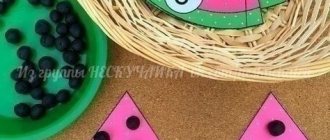The purpose of the didactic game “Professions”
The goal of the game is to expand and consolidate ideas about all kinds of professions, their characteristics and importance for society, the working tools used, and the products produced.
Game objectives:
- remembering the names of professions;
- expanding knowledge about the tools and devices needed to perform professional duties;
- clarification of the purpose and characteristics of professions;
- clarifying the idea of where people work, what clothes they wear, what actions they perform, and what their workplace looks like;
- developing an idea of what employees should know and be able to do;
- fostering a respectful and grateful attitude towards the work of others;
- developing an understanding that every profession is important, and the results of work are of great importance;
- instilling the desire to work hard and become a good worker;
- development of speech skills, the ability to think logically and perceive information by ear.
Childhood
Didactic games to familiarize yourself with the outside world on the topic “Professions of People.”
The purpose of studying the topic: to continue to expand children’s understanding of various professions, their names and types of activities.
To cultivate respect for the work of adults, the desire to choose a profession and the need to work. “Who does what?”
Target.
Fix the names of actions performed by people of different professions. Progress of the game. Children take a picture of a person in a certain profession and say what he does. Cook... (cooks food), doctor... (heals people), teacher... (teaches children), builder... (builds houses), artist... (paints pictures), pianist... (plays the piano), writer... (writes books), dressmaker...(sews clothes), laundress...(washes clothes), cleaner...(mops floors), salesman...(sells goods), photographer...(takes photographs of people), teacher...(raises children), weaver...(weaves fabrics), machinist …(drives the train), controller…(checks tickets), typist…(types), etc. “Who knows more professions”
Purpose.
Teach children to correlate the actions of people with their profession, to form corresponding verbs from nouns (builder - builds, teacher - teaches, etc.). Progress of the game. Educator. I work in a kindergarten as a teacher. This is my profession. I teach you how to behave, play with you, draw, read you poems, stories, walk with you, put you to bed... This is my profession - to educate you. What is Irina Vladimirovna’s profession? She is preparing lunch for us. That's right, cook. What other professions do you know? (Answers.) Every adult necessarily learns some profession. Having mastered it, he goes to work and performs certain actions. What does a cook do? (Children: The cook cooks, bakes, fries, peels vegetables.) What does the doctor do? (Examines patients, listens, treats, gives medicine, gives injections, operations.) What does a tailor do? (Cuts, bastes, flogs, irons, tries on, sews.) The teacher names other professions - builder, teacher, shepherd, shoemaker, and the children name actions. “ Pronounce it correctly.”
Target.
Forming the correct pronunciation of sounds, consolidating the names of professions. Progress of the game. Learn pure tongue twisters or tongue twisters, jokes, so that when repeated, whistling and hissing sounds are clearly pronounced; — The watchmaker, squinting his eye, is fixing the watch for us. — The water carrier was carrying water from the water supply system. — The old watchman Tom is guarding the house. — The weaver is weaving fabric for Tanya’s dress. - The baker baked a bagel, a bagel, a loaf and a loaf of dough early in the morning - The roofer Kirill roofed the roof crookedly. Grisha was invited to re-roof. - Porridge, porridge, yogurt, our cook Masha, instead of porridge, she prepared an omelette for lunch. “Professions”
Purpose.
Fix the names of professions and actions that are performed by them. Progress of the game. You ask your child the question: “What does…..?” and name a representative of any profession, and the child answers. At first, it is better to take professions from which the answer follows - a teacher educates, a baker bakes, a janitor cleans. Alternate well-known professions with unfamiliar ones, and at the same time tell about professions unknown to the child. It turns out interesting if you ask in a row “What does a doctor do?”, “What does a veterinarian do?” (make out the difference), and then also “teacher” and “scientist”. Sometimes you hear interesting versions from children. “Give me a word.”
(“Add-ons”). Target. Develop logical thinking, attention, memory; learn to select words to rhyme. Progress of the game. Children suggest words and finish the poem. In the carpenter's bag you will find a hammer and a sharp... (knife). Any tool is available - a plane, and... (a chisel). Popov S.A. We must fight fire. We are brave workers. We are partners with water. People really need us. So who are we? - ... (firemen). I would definitely want to become a pilot, I would then take a plane to Moscow... (Fly). The pilot lifts Deleanu Liviu into the blue sky... (plane). Stepanov V. Kicked the goats out onto a cheerful hillock... (shepherd boy). Demchenko G. But our painter does not come into the house with a brush and a bucket: Instead of a brush, he brought a mechanical... (pump). Baruzdin S. So that people do not get wet in the rain The roofer covers with iron... (house). Baruzdin S. White sawdust is flying, flying from under the saw: This is a carpenter making frames and... (floors). Baruzdin S. Every day he brings a newspaper to our house... (postman). The roof is being painted in front of the children... (painters). I fly dolls in the morning. Today I... (nurse). Shigaev Yu. It's time to paint the rooms. They invited... (painter). Baruzdin S. The circus performer knows how to prance, animals and birds... (train). The future cabin boy brought us some southern fish... (sailor).
Didactic games “Professions” in the senior group
Preschoolers in the older group should already know a wide range of professions, as well as have an idea of the professional responsibilities of different workers and the tools they use.
List professions starting with the selected letter
The teacher places cards with letters face down on the table. Children take turns coming to the table, taking a card, calling professions that begin with the chosen letter:
- A – actor, agronomist, astrologer, administrator, aviator, lawyer, architect, obstetrician;
- B – accountant, bookseller, bartender, banker, accordion player, librarian, ballerina, boxer;
- B – doctor, makeup artist, driver, diver, teacher, veterinarian;
- G – geologist, governess, loader, make-up artist;
- D – janitor, conductor, designer, nutritionist, truck driver, milkmaid, dispatcher, director;
- F – livestock breeder, journalist, jockey;
- Z – sound engineer, zoologist, manager;
- I – inspector, engineer, inventor, art critic, illustrator, historian;
- K - astronaut, clown, captain, combine operator, composer, cashier, fireman, blacksmith;
- L – laboratory assistant, pilot, lumberjack, speech therapist;
- M – driver, fashion model, painter, nurse, meteorologist, mechanic, installer, musician;
- N – nanny, notary, oil worker;
- O – ophthalmologist, waiter, operator, landscaper, security guard;
- P – shepherd, cook, pediatrician, writer, hairdresser, pianist, carpenter, postman, salesman;
- R – director, radio operator, fisherman, reporter;
- S – secretary, plumber, gardener, violinist, mechanic, sculptor, dentist;
- T – tractor driver, turner, chimney sweep, trainer;
- U – cleaner, teacher, scientist;
- F – photographer, florist, pharmacist, farmer, philosopher, football player;
- X – surgeon, artist, choreographer;
- Sh – miner, seamstress, driver, plasterer;
- E – ecologist, electrician, tour guide, economist, excavator operator;
- Yu is a lawyer, cabin boy, jeweler.
What is this builder called?
The game introduces preschoolers to construction professions. The teacher says what the person does, and the children answer what they call him:
- paints walls - painter;
- covers the roof with tiles - a roofer;
- builds a house from brick - mason;
- connects metal parts - a welder;
- lays tiles on the walls - a tiler;
- makes the walls smooth, applies plaster - plasterer;
- makes parts from wood - carpenter.
Name your profession based on the result of your work
The teacher shows the pupils cards depicting the result of the work, and they must guess who is doing the work. For example, the picture “suit” is the profession “seamstress”. Or “cake” – “confectioner”. Or “house” – “builder”.
Name the extra item
The teacher places in front of the children 4 illustrations of tools used by certain workers. One of the items is superfluous, it must be pointed out with an explanation of the reason for the choice. For example, “trowel”, “helmet”, “drill”, “syringe” - the first three are used by a builder, the last item is used by a nurse.
Ambulance
The game forms in preschoolers an idea of the importance of the medical profession. For the lesson, you need to prepare pictures depicting the tools and consumables that emergency personnel use: a syringe, bandage, iodine, thermometer, bandage, etc.
During the game, different situations are considered. One child plays a doctor, the second plays a patient. The second one tells what problem he has: a broken knee, a scratched hand, bleeding from the nose, sore throat, headache, etc. The child playing the doctor tells what tools and medicines he will use in each specific case. If necessary, the teacher prompts him.
Pharmacy
A role-playing game introduces preschoolers to the profession of a pharmacist. For the lesson you need to prepare pictures depicting medicines and cards imitating “money”. Children distribute roles. One becomes a pharmacist at the cash register, the rest become customers. The roles alternately change.
Customers take turns “entering the pharmacy.” They say that they are worried about whether the medicine they need is available. The pharmacist offers the buyer a product and collects payment. The teacher helps the players, gives tips on prescribing medications, and asks leading questions.
Didactic games on the topic “Professions” 3-4 years
Didactic games
Didactic board game on the topic : “ Professions ”
.
for children 4-7 years old
Goal: expand children's understanding of various professions , their names and types of activities. Introduce tools and instruments needed by people of these professions and relate them. Foster respect for the work of adults.
Progress of the game: Participants are asked to take turns naming the professions that they already know and the tools that people in these professions , then try to correlate the actions of people with their profession , forming corresponding verbs from nouns (educator - educates, builder - builds, etc.)
.
The teacher draws the children's attention to the fact that unusual chests have appeared in the group, people of different professions , but they are empty, all the tools are mixed up, and people cannot work. Give the children a chest each. Then the adult invites one participant at a time to his table (everyone can sit at a round table)
. He takes the card and says what is shown on it. The rest of the children must name someone, this item is needed for work, and put it in the chest. If the children find it difficult to answer, explain what it is like with children, remember where they saw such an employee.
Let's show the doll how a hairdresser works
Goals:
· Clarify knowledge about the work of a hairdresser;
· Continue to formulate the idea of the need to maintain a clean body and a neat appearance.
Equipment:
2 dolls, attributes for playing hairdresser.
Contents of the game.
The teacher brings a large doll, which says that it came from another kindergarten, where the children do not know how to play hairdresser. The teacher asks to help the doll, tell and show how to play this game.
The teacher clarifies with the children what items are needed, how to prepare the place for the game, and offers to explain and show the actions of the hairdresser. The scope of actions depends on the children’s corresponding ideas.
Let's make beautiful hairstyles for the dolls
Goals:
· Strengthen the skills of caring for hair, etc.), asks to put them in order, to do their hair. She clarifies what items are needed for this, draws attention to the fact that the dolls’ hair is of different lengths, so their hairstyles should be different. The teacher suggests remembering what hairstyles can be made from long and short hair and shows some techniques; children continue to work with hair;
· Specify the names of the items required for this;
· Form the concept of “neat appearance.”
Equipment:
dolls with hair of different lengths, hair care items.
Contents of the exercise.
The teacher draws the children's attention to the unkempt appearance of the dolls (they are without socks and shoes, their hair is not neat)
«Determine the profession by subject
».
Goal: To consolidate an understanding of the purpose and functions of objects of labor, the ability to group them by method of use.
Procedure: Children take turns taking out objects from the bag (ladle, cotton wool, coins, comb, paint, threads, syringe, etc., which are necessary for one or another professional activity. Task: for the object, name the profession in which it is used.
"We're going to work"
Target:
teach children to navigate the space of the room, find their place in accordance with visual landmarks - pictures depicting professional symbols. Develop attention and memory during this game.
Game actions:
moving around the room (depicting a car ride) and finding a chair or place with the corresponding professional symbols (picture).
Game equipment:
“rudders” (circles with people of different professions drawn in the middle) are laid out on the teacher’s table; there are chairs in different places in the room, with pictures depicting tools on them.
Progress of the game:
the teacher invites the children to his table, everyone can choose a profession, take the steering wheel and go to work, to do this you need to carefully look at the chairs and choose a picture with a tool suitable for this job. The game is played several times, the teacher rearranges the pictures on the chairs, and the children must find their place again. Then the children change rudders (professions), and the game is repeated
“What does Masha want to do?”
Target:
clarify children’s ideas about certain work activities; about materials, tools and equipment needed for work.
Progress of the game: in
The teacher addresses the children on behalf of Masha (doll):
- Masha asks me for a basin, a bucket of water and soap.
Submits the objects she calls to the doll.
- What do you think she will do? (Wash.) That's right. And now Masha asks to give her a saucepan, milk, sugar, salt and millet. What is Masha going to do? (The doll wants to cook porridge.) What is the name of the porridge? (Millet.)
Other work activities that require appropriate items can be considered in a playful form. The kids are shown these items (an iron and a stack of doll's laundry - for ironing; a bucket and a watering can - for watering the beds, etc.).
When playing this game with older children, the teacher uses pictures depicting objects corresponding to a particular type of labor, or simply lists these objects (without showing illustrations), asking the children to guess more complex labor processes. For example: scissors, colored paper, glue, ruler, pencil - gluing books, repairing boxes, paraphernalia.
The game can be complicated: one child draws objects on the board, and the rest of the children guess the type of work, or all children simultaneously draw on paper, and then show the drawings to each other and guess.
«Guess what I'm doing?
Target
: expand children’s understanding of labor activities; develop attention.
Progress of the game:
The teacher and children join hands and stand in a circle. A child comes to the center of the circle. Everyone goes in a circle and says:
We don’t know what you’re doing,
Let's take a look and guess.
The child imitates labor actions not only with movements, but also (if possible) with sounds. For example, he cleans the floor with a vacuum cleaner, hammers a nail, saws, drives a car, does laundry, carries a bucket of water, wipes a mirror, chops wood, grates, turns something in a meat grinder, etc.
Children guess the actions.
“What do they do with this object?”
Target:
teach children to select words indicating the action performed by the object and who uses this object.
For example:
With a brush - (what are they doing?) - Drawing, (who?) - Artists, children.
With scissors - (what are they doing?) - Cutting, (who?) - Cutters, hairdressers.
With a needle - (what do they do?) - Sew, (who?) - Seamstresses, embroiderers.
With a shovel - (what are they doing?) - Digging, (who?) - Gardeners.
With a pen - (what do they do?) - Write, (who?) - Teachers, writers, accountants.
With an ax - (what are they doing?) - Chopping (who?) - Carpenters, foresters.
With a thermometer - (what are they doing?) - They measure the temperature, (who?) - Doctors, weather forecasters.
With a ruler - (what are they doing?) - Measuring, (who?) - Engineers, designers, schoolchildren.
With a broom - (what are they doing?) - Sweeping, (who?) - Janitors, etc.
“For a person in what profession is this necessary?”
Target:
expand children’s understanding of the items necessary for a person in a certain profession.
Progress of the game:
Scales, counter, goods, cash register... - to the seller.
Broom, shovel, hose, sand, crowbar, snow blower... - to the janitor.
Washing machine, bath, soap, iron... - to the laundress.
Comb, scissors, hair dryer, shampoo, hairspray, hair clipper... - to the hairdresser, etc.
"Guess the profession"
Target:
expand children’s understanding of the profession; find out what profession we are talking about.
Progress of the game:
This person is the owner of a wonderful palace of books. She is sincerely glad to see everyone who comes to visit her. And most importantly, guests will never leave her empty-handed. She gives them interesting books to take home. After reading, they can be exchanged for others. She will always help young and adult readers find the right book. (Librarian).
When you are hungry and come to the group for lunch, it already smells delicious. Who did this hard? Who prepared this tasty and aromatic dish? This is her favorite pastime, she does it with great love, that’s why everyone likes the food so much. For what a person does with pleasure and love brings joy not only to herself, but also to everyone else. Who is this? (Cook).
And this man greets his patient with a smile, quickly drives away unbearable pain, and cures all kinds of diseases. Once in his childhood, this man came to the aid of sick animals and loved ones, because he loved them very much and tried to reject the pain. And then I realized that I couldn’t live without it, so I studied for a long time and became (a Doctor).
When you come to kindergarten, everything around you is clean, comfortable, and fresh air. Not a speck of dust anywhere. The floor has been washed, the glass on the windows is so transparent that it is almost invisible. This person loves cleanliness very much and does his job with pleasure. She has great talent for this. Whose hands is this work? (Cleaners, assistant teacher).
Didactic games “Professions” in the middle group
The task of a teacher in the middle group is to expand and consolidate students’ knowledge about different professions, develop their thinking ability, concentration, ability to navigate, and give clear and competent answers.
What to whom?
To get acquainted with professions, the presenter names the worker, and the children must list the tools, devices and materials that he uses:
- doctor - syringe, stethoscope, medical gown, rubber gloves, bandage, medical card;
- builder - drill, hammer, bricks, boards, helmet, concrete, nails, saw;
- teacher - pointer, class magazine, textbooks, wall maps, blackboard;
- artist - paints, brushes, canvas, palette, easel, paper, pencils;
- cook - dishes, oven, blender, cap, apron, food, recipe book;
- hairdresser - hair dryer, combs, scissors, curling iron, hair dyes, hairpins, mirror;
- gardener - rake, gloves, shovel, seedlings, lawn mower, pruning shears, watering can;
- seamstress - sewing machine, iron, ironing board, scissors, fabric, needles, threads.
This is true?
For the game you need to prepare pictures depicting people of different professions in appropriate attire. Each player receives two cards: red – the answer is “no”, green – “yes”.
The presenter shows the children a picture and says who the person drawn works for. Players must understand whether what is said is true and raise the appropriate card. For example, the presenter, showing a picture of a fireman, says: “This is a teacher.” Children hold up a red card.
Work clothes
To play, you need to cut out paper images of a girl and a guy, as well as different work clothes.
The teacher says that the paper characters are going to go to work, but they need help choosing the right suit. The game can be built in different ways. The teacher names a profession, and the children choose the correct one from a heap of paper clothes. Or the teacher chooses the costume himself, and the players name the character’s place of work. When the children have sorted out their work wardrobe, the teacher asks them to close their eyes to consolidate the acquired knowledge, and he himself rearranges the clothes and asks them to find the mistake.
Work transport
To play, you need to arrange chairs and attach to each chair an image of a specific car: ambulance, fire, police, bus, plane, train and others. And cut out “steering wheels” from cardboard with professions written on them.
The presenter gives each player a steering wheel and names their profession. The player must find his “car”, sit on a chair, steer, “going to work”. The game is repeated, the presenter changes the players' steering wheels.
For a cook or a doctor?
This didactic game “Professions” for kindergarten systematizes ideas about the work responsibilities and professional characteristics of a cook and a doctor.
Two children are playing: one is a cook, the other is a doctor. The presenter pulls items out of the bag and asks which worker needs them. For example, a doctor needs a syringe, a cook needs a spoon. Children should not just answer, but explain why the employee needs this item.
Didactic games for early career guidance
DIDACTICAL GAMES ON EARLY CAREER GUIDANCE
Didactic game “Guess the profession”
Target.
Expand children's ideas about professions.
Progress of the game.
The teacher shows the children an object picture. Children name the person’s profession and show a picture in whose work this object is used or is the result of his work.
Interactive game “What items are needed for work?”
Target.
To consolidate children’s ideas about objects and their use in work processes. Systematize knowledge about the professions of “bricklayer”, “crane operator”, “welder”, “painter”...
Didactic game “Who needs what”
Target.
To form children's ideas about the construction profession.
Teach children to find tools and materials needed by people in this profession. Develop children's attention, memory and speech. Didactic game “What is useful in case of fire”
Purpose.
Teach children to find an object that can be useful to a firefighter when putting out a fire. Explain your choice. Develop logical thinking.
Preparation.
It is necessary to prepare pictures depicting items that may be useful in a fire, and items that are not needed in a fire. Prepare playing fields on which players will place cards.
1 game option
: presenter and children. The presenter asks the children a question: Find an item that will be needed in a fire (not needed in a fire) and place it on the field that is on the right side (left side). The child must find an item that will be needed in case of a fire (not needed in case of a fire) and assign it to a specific field and explain his choice.
Game option 2:
played by 2 players. The cards are divided equally between the players, each player chooses suitable ones from their cards (for example, those that will be useful in case of fire). Cards that do not suit the player must be exchanged with the second player. You can exchange them in the following way: explain why this or that item is needed (or why it is not needed) in case of a fire.
Didactic game “Loto. Professions"
Target:
consolidate knowledge about professions; concentration of attention; early career guidance for preschool children; respect for the work of adults.
Rules of the game
The game can be played by two to eight players.
Children are given cards with pictures of people involved in any profession. There are empty fields around the image. One child can take from one to two or three cards.
The teacher (leader) lays out cut cards in front of him with images of tools, clothing and materials related to professions. Next, the teacher randomly picks up a card and names the object. The player whose card has the profession corresponding to the named instrument takes the card and places it on an empty square.
Didactic games “Professions” in the younger group
Preschoolers of the younger group learn through games how important all professions are and what different workers do.
Salon
Pupils do the dolls' hairstyles and take care of their hair using various devices and products. The teacher observes the work of the pupils, coordinates them, and suggests rules for caring for their appearance. It is important to draw children’s attention to how ugly dolls look while they are unkempt and unkempt, which means that the profession of a hairdresser is necessary. You should also tell children about the tools used in the hairdressing salon and their purpose.
Guess the profession based on the subject
The teacher pulls an item out of the bag, and the children say who might need it. For example, a cook needs a ladle, a nurse needs a bandage, a painter needs a brush, and a hair dryer needs a hair dryer.
Guess who am I?
Children stand in a circle. Each player, in turn, goes to the center and begins to depict a certain action, without saying a word, using only facial expressions, body movements, and inarticulate sounds. The rest must guess who the comrade is portraying. For example, a child makes twisting movements with his hands, imitating a steering wheel, and says “w-w-w.” This is the driver.
Correct mistakes
The presenter names paired phrases, and the children say what the mistake is and how to say it correctly:
- the teacher mows the lawn and the gardener writes on the blackboard;
- a barber puts out a fire, and a fireman does a haircut;
- a musician paints the walls and a painter plays the piano;
- the nurse prepares a pie, and the cook gives an injection to the patient;
- the builder offers books to readers, and the librarian builds brick walls.
Progress of the game:
There is a stove in front of the children. On it is a pot, a frying pan (toys, quite large, or real dishes)
; next to it is a set of vegetables (natural, a bowl of water, a knife, a spoon.
Educator: - I will teach you how to cook delicious soup from vegetables! Standing on the stove (show)
. ?
- Large saucepan.
— There is water in this pan. Look (scoops up water with a spoon and pours it back)
.
The water will boil soon, so it's time to peel the potatoes .
The teacher asks one of the children to find and give him potatoes , washes them in a bowl, and peels them. Children name the actions and repeat the names.
The teacher asks what the potatoes .
-It is white, clean without skin (skin)
.
- Throw it into the pan whole or. ?
- We need to cut it.
The teacher puts the onions in the pan. Then the children bring cabbage and carrots and watch as the teacher washes and chops the vegetables. Separately, he fries the onion in a frying pan (the children name the vegetable and the action with it)
.
Educator: “Listen,” says the teacher, “how the oil sizzles in a hot frying pan: sh-sh-sh. How does it sizzle?
The teacher puts the onions in the pan and stirs the soup.
He says: “It’s a pity that it doesn’t burn.”
our stove. But now we’ll cook vegetables, vegetable soup, on a real stove.”
When the cook arrives, the teacher hands him the pan. He is interested in what is in it, listens to the children , approves and clarifies their answers. He promises to cook soup.
Note. It is advisable that vegetable soup be prepared for lunch on this day. This will bring joy to the children.
№ 13. "Who's doing what?"
.
Goal: to develop the ability to correlate a person’s actions with his professional activities ; cultivate respect for working people.
The teacher hands out cards depicting representatives of various professions . Then he shows object pictures depicting the object of their activity, while asking questions: “Who builds houses?”
;
“Who sews dresses?”
,
“Who sells milk?”
etc. Examples of
children's : “A builder builds houses
,
“A tailor sews dresses
,
“A salesman sells milk
.
№ 14. “Who needs what?”
.
Goal: to systematize knowledge about the professions of a cook and a doctor ; about the objects of their labor.
The teacher calls two children . One wears a chef's cap, the other wears a doctor's cap (with a red cross)
.
He seats them at the table facing the rest of the class participants. Invites a third child to the table. He invites him to take the thing out of the box and, naming it, hand it over to its destination: either the cook or the doctor. The one who received the thing must name it and tell what it is used for, for example: “This is a meat grinder, you can grind meat, bread, onions and make cutlets
.
During the game, the composition of its participants changes once or, if time permits, 2 times.
№ 15. "Parsley goes to work"
.
Objectives: To teach how to classify objects according to their functional purpose (satisfying labor needs)
; cultivate a desire to help adults.
Equipment: Pictures depicting items necessary for play and work in the garden, in the kitchen, in the apartment; three layouts (garden, kitchen, room)
Progress of the game: A letter arrives from Petrushka, in which he says that he is visiting his grandmother. He plays, draws, walks, and also helps his grandmother. Today she gave him three tasks: plant carrots in the garden and water the flowers; cook soup; clean up the room (put away toys, wipe off dust, vacuum)
. However, Petrushka got confused in the tools and asks the guys to help.
The teacher offers the children models of the garden, kitchen and room and explains that they need to take one picture , look carefully, name the item, tell how to use it and what kind of work it is needed for, then put the picture on the corresponding model. For example, a vacuum cleaner is needed to clean a rug, it needs to be turned on and vacuumed, so a picture with a picture of a vacuum cleaner needs to be placed on the room layout. The teacher draws the children's attention to the fact that among the pictures with tools there are pictures with toys . They need to be selected and put in a box. The task is considered completed if all the pictures are arranged correctly .
At the end of the game, the teacher invites the children to tell Petrushka in a letter what items he needs to complete his grandmother’s tasks.
№ 16. «Professions»
.
Goal: to develop an understanding of professions , enrichment and replenishment of the vocabulary of words; development of imagination, thinking, word formation skills.
Inventory: Not required.
Content: The presenter begins the sentence, the children must complete it by inserting the missing words. Or he asks a question, and the children answer. There are many options for such games; below are a few examples.
Didactic games “Professions” in the preparatory group
Older preschoolers are preparing for school, so games are important for them to develop speech and improve their skills in correctly forming sentences.
Divide the word
The presenter names a profession formed from two words. Children try to break it into pieces to find out the meaning. For example, “chimney sweep - pipes and clean”, “fisherman - fish and catch.”
Choose a word for your profession
The player’s task is to choose a suitable epithet for the profession. For example, “the teacher is kind,” “the ballerina is slender,” “the nurse is caring.”
Continue the sentence
The teacher begins a sentence concerning the professional responsibilities of various workers, and the students complete it by listing the objects of action. Eg:
- the gardener waters... the lawn, flower bed, bushes, trees, beds;
- the cook cuts with a knife... meat, vegetables, fish, fruits, bread;
- the driver carries passengers by... taxi, bus, tram, trolleybus.
